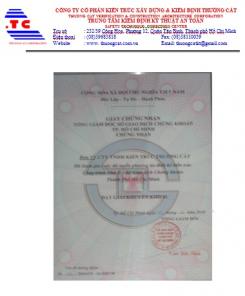verify
- Inspection Equipment Lift
- Elevator Inspection
- Inspection Forklift
- Crane Inspection
- Inspection Palang
- Pressure Testing Device
- Boiler Inspection
- Inspection Compressor
- Inspection Systems Lightning
- Inspection Machine Builders
adv left
Inspection of steel cables
Cable inspection is checked and calculated so that they meet the safety level. Today, cables are used in factories and factories. But the problem of safety in many places has not really paid much attention.
A steel cable is a complex object in which the fibers are positioned under different lifting angles compared to the centerline of the cable. If the cable is wound through a pulley or tang, and is subjected to a certain amount of traction, its individual fibers are subjected to very different types of stress:
- Twisted wires from strands.
- Bending by cable winding up pulley or tang.
- Pressure punching of adjacent yarns and by contact between the outer yarns and surfacing grooves.
- Pull by the effect of the traction or weight of the lifting device.
These stresses depend on the diameter, the number of fibers, the number of ropes, the lifting angle of the fibers in the rope and the number of ropes in the rope, the material of the core and the cable, the braiding, the braiding, the friction between the individual fiber VV ....
The effect of all these elements can not be expressed in a formula. Many studies and experiments have shown that the long-term durability of the cable depends on the major factors: the maximum tensile strength smax and the ratio 'between the diameter of the pulley or tang of the cable diameter.
During work, frequent load changes have the effect of fatigue of the fiber material and one of the causes of cable damage when using them on the shaft. The wear of the fibers at the contact and at the contact of the fibers with the groove or pulley surface also increases the fatigue phenomenon.
Working conditions also affect the durability of the cable. Dust in the air attaches to the cable, increases wear of fibers, acid and alkaline vapors in workshops, chemicals, and seawater that increase fiber rust, high temperature in metallurgical workshops. reduces lubrication conditions and makes fibers wear out. The torsion of the lifting gear when the work shaft increases the friction between the cable and the groove and friction between the cables. All this reduces the service life of the cable.
Cable current is calculated according to the pull force. To select the size of cable according to the standard of the cable tensile force is determined and compared with the permissible breaking force of the cable in the table, from which to choose the appropriate cable diameter. The pulling force of the cable is calculated according to the following formula:
Cable Inspection - Figure 1
where: n - coefficient of safety, spread according to table 3.1.
Note: Due to the uneven distribution of tensile and bending stresses in the strands of the cables and because the axes of the fibers, of the wire and of the cables do not overlap, the total traction of the cable is always smaller than the total Tensile strength of the fibers.
In addition to the safety factor, the durability of the cable increases with the diameter of the pulley or diameter of the cable diameter.
In winches for lifting in all cases, cables not smaller than 7 mm in diameter may be used.
The method of cable traction is the conventional method, because it does not reflect the actual working conditions of the cable and can not determine the durability of the cable. Actual durability of the cable depends a lot on the working mode. The durability of the cable depends on the number of wires on the pulley and the tangle, which method is calculated on
Not to mention the number of bends. The safety factor in formula (3.1) does not reflect the physical meaning of the cable breakage process.
Application of cable gates Working mode Coefficient n
Lifting and lifting handles 4.0
Lightweight 5.0
Medium 5.5
Heavy, very heavy 6.0
Wire, bucket:
- Grab a wire and td - 5,0
- Bucket grabbed a driving mechanism
5.0
- Grab bucket two drive mechanism (assuming bucket weight and material distributed evenly on the wire branch)
6.0
Wire holding the rod, hold the object - 3.5
Wire for machine assembly - 4,0
Used to lift people - 9.0
With the same coefficient of safety different cable structures in the same working condition have different shelf life, ie the actual stress in the cable depends on its sentence, and hence the coefficient Safety is not a comprehensive feature of the cable.
At present there are methods of calculation and testing of cables that determine the size of the cable, the diameter of the pulley and the tang not only depend on the traction but also depend on the bending stress, the the characteristics of the cable structure, shaft type and longevity of the cable. However, the calculation methods are very complex and therefore the method of calculation used today is the method of calculating cable tension.
In the course of work the cable breakage does not occur instantaneously, but develops gradually. So when the first individual fibers are broken, this only signals that the cable breakage process has started, but not in the rush to replace the new cable because of the high number of fibers in the cable and the 'safe' high. If the fiber is broken in a step not exceeding the value specified in Table 3.2, the cable can still work safely.
Table 3.2. Limit the number of strands broken, allowing one-step lengths
Cable termination
Safety factor 6 × 19 = 114 fibers 6 × 37 = 222 fibers
Braided Down Side Down Side Down Braided
<6 6 12 11 22
6 7 14 13 26
7 8 16 15 30
3. Connect the other end of the cable
Cable Inspection - Figure 2
The spigot shaft needle (H.3.5a, detail 1) protects the cable from high stresses and from rubbing on the shaft. The lining is a closed loop with groove section, which is machined by forging or stamping. The shape of the groove corresponds to the cable diameter. The cable is looped through the ring, in the groove, one end is connected to the cable body by means of pairs of bolts (H, 3.5a, part 2) or by braiding (H.3.5b, c). In the case of clamping of the cable head by bolts, the number of bolt connections shall be determined in accordance with the calculation, but shall not be less than three and shall be dependent on the diameter of the cable according to the following table:
Cable diameter, mm 11-18 19-24 25-31 32-34 35-37 38-44
Number plate pairs 3 4 5 6 7 8
The pitch of the stud bolts and the free cable tip lengths are not less than six times the cable diameter of the outer bolt.
How to braid the cable: unfasten the cable end, thread the wire into the cable body and then use the steel wire wrapped on a length of 20 times greater than the cable diameter. This method is expensive and unreliable, so less use.
Pair of leaded hoses with leaded lead (H.3.5d). To pair, one end of the cable through the hole of the steel cone (no welded or cast iron); Remove the fibers at the end of the cable by about two times the length of the taper tube, cut off the middle core, clean the fibers with acid, and rinse them in warm water. Then fold the fibers in half, pull back and pour lead or tin into the tube. Before pouring lead or tin into the tube, the tube should be heated to about 100 ° C to allow the liquid to fill up into volume. Note that if the temperature of the pouring agent exceeds 400 ° C, the strength of the fibers is reduced. If the temperature of the pouring agent reaches 520 ° C, the fiber's durability decreases by 20%. It is therefore advisable to only use materials with a melting temperature of 330 - 360 ° c. '
In addition to the above measures, the cable pair using the shim (H.3.5e) is very popular and convenient. The cable pair is connected and disassembled very quickly, only by hand, no need specialized equipment, but very secure.
Hopefully with the article on steel cable testing as well as how to calculate their durability. We have brought a bit of knowledge about them. And solve your problem.








